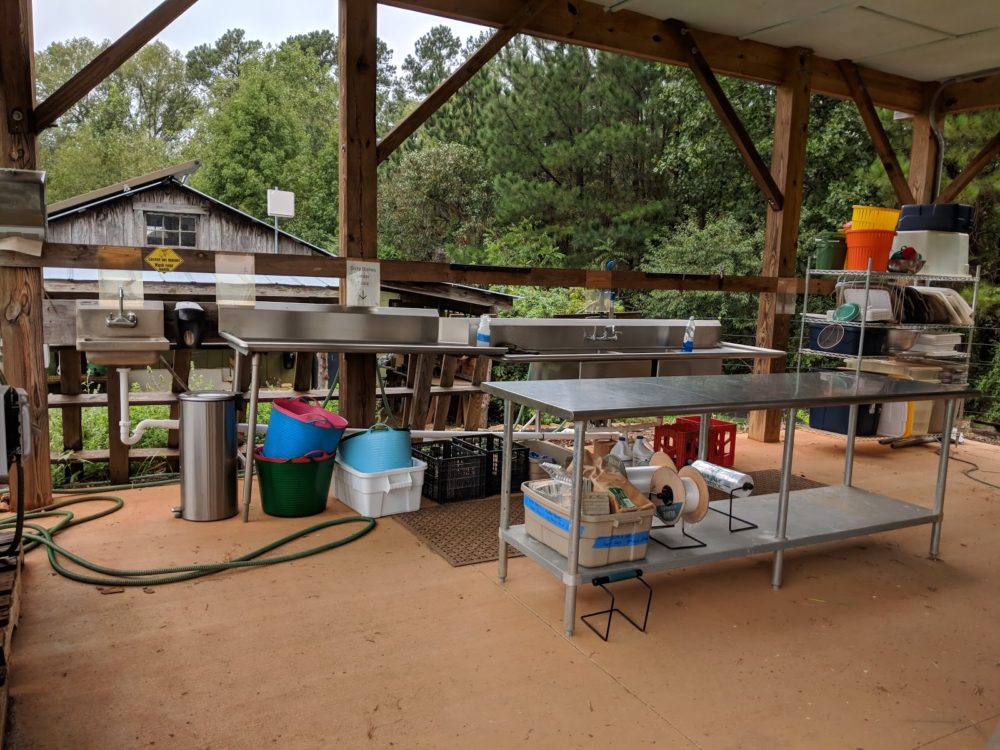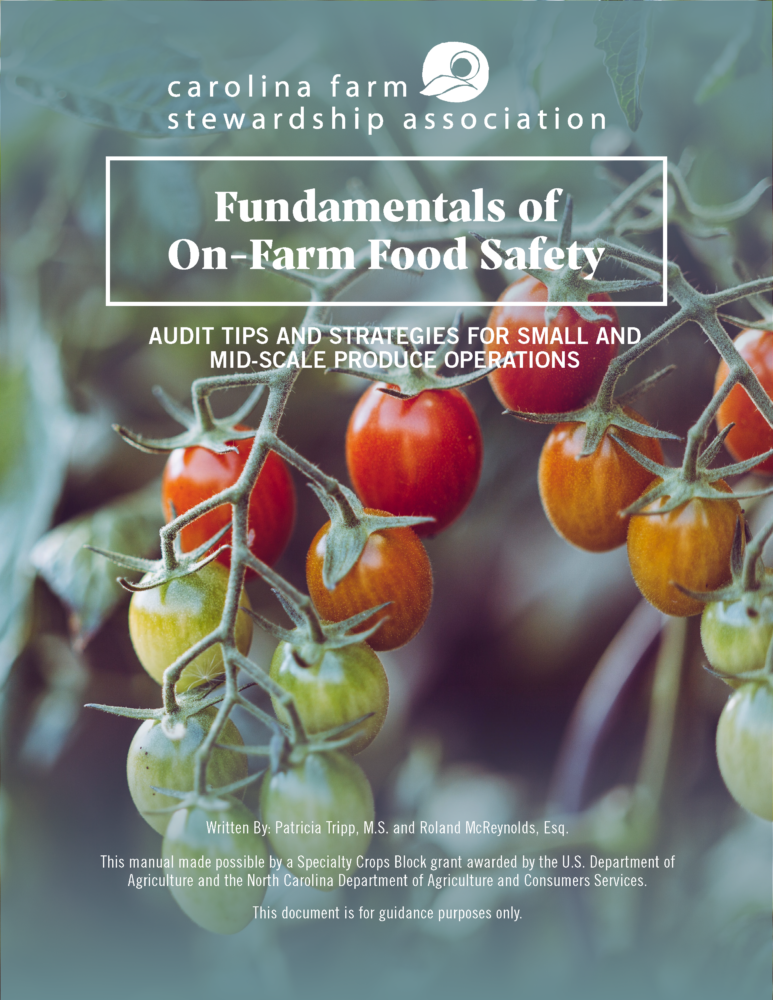by Chloe Johnson, CFSA Local Food System Manager | Wednesday, Jan. 14, 2021 —

Post-Harvest Station at Central Carolina Community College Student Farm (a CFSA member)
Are you thinking of adding a post-harvest produce washing station to your farm’s infrastructure this upcoming year? If so, here are some things to consider.
Most important, you should know this does not have to be a complex system. Ideally, you would have a triple stainless-steel sink, plenty of food-safe surfaces for drying your produce, with a roof over the entire set-up. However, all these components aren’t absolutely necessary.
Before we discuss the infrastructure, make sure you ask yourself: Why do I want to wash my vegetables at all? Get clear about your reasons. You might be under the impression that buyers prefer washed produce because of food safety concerns. For an informed buyer, this is not true.
Water is a strong vector for the transfer of pathogens, so washing your produce actually introduces food safety risks to your produce. Immersing multiple heads of lettuce in the same water allows potential pathogens to dislodge from one head of lettuce, travel through the water, and potentially land on another head of lettuce. The use of sanitizers in wash water (discussed below) will mitigate this risk.
Water is a strong vector for the transfer of pathogens, so washing your produce actually introduces food safety risks to your produce.
Furthermore, water itself can easily become contaminated, which is why food safety programs require water testing to ensure a clean water supply. Some produce doesn’t handle water immersion well, and for post-harvest quality, you have to find a way to adequately dry the produce you’ve washed—adding several more steps and a lot more time to getting your produce market-ready. Another post-harvest quality concern is infiltration (see video below). Produce that is cooled too rapidly will take in water, which isn’t good for produce quality and is very dangerous from a food safety standpoint.
The purpose of washing produce is to remove dirt and debris. Adding a sanitizer to your wash water does not sanitize individual pieces of produce, all it does is contain any potential contamination. This is why rules around food safety focus on prevention—once a piece of produce is contaminated, it is hard, if not impossible, to decontaminate that individual piece. It is much easier to keep any contamination contained and unable to spread to other produce.
All this to say if you have produce that isn’t sandy or dirty, you might be better off skipping the washing step altogether! Do take note that cleaning root vegetables on a spray line—where the water touches a single piece of produce and is allowed to fall through a wire mesh to the ground—doesn’t create the same risk of pathogen spread as long as your water itself is clean.
There are times, however, that you can’t help but have gritty leafy greens that need a good soak before packing them up for sale. Individual consumers also often prefer washed produce because it is more palatable and convenient. If you are selling direct-to-consumer, or even to some smaller retailers, you might get requests that you wash your produce.
How can you set up a washing system with the smallest amount of infrastructure investment?
The size of your setup will obviously have to shift according to the volume you process at one time. You can purchase used stainless-steel sinks, but if you go this route be sure to closely inspect the sinks for any signs of damage or corrosion that would make it difficult to fully clean and sanitize equipment. Especially look for clunky welds that will harbor pathogens and, potentially, rust.
For your wash basin, you want something you can easily drain and that has a cleanable, sanitizable surface—a smooth plastic that won’t leach or stainless steel are the best options. You may only need one large basin. If your produce releases a lot of dirt into the wash water, or your sanitizer requires a rinse step, then you will need up to three basins for your washing process.
Sanitizer
If you want to use a sanitizer in your wash water to mitigate the risks of cross-contamination, germicidal bleach and a product called Sanidate 5.0 are the most common wash water sanitizers we see in the field. These are by no means your only options, though. Several brands make products with ingredients ranging from peroxyacetic acid, hydrogen peroxide (Tsunami 100), or ozone.
Questions you should ask when choosing a sanitizer are:
- Is the sanitizer EPA approved and labeled for food contact?
- Does the sanitizer require a rinse step?
- If relevant to your operation, is the sanitizer OMRI approved?
- Is the sanitizer corrosive to metal? If so, do I need multiple sanitizers as part of my operation?
- How stable is the sanitizer (i.e., how often will sanitizer levels fluctuate in my wash water)?
Any sanitizer you use MUST be EPA approved and labeled for food contact. The Produce Safety Alliance has an extensive resource available to search any sanitizer on the market to check what it has been approved for. Quickly access the sanitizer’s label and determine if it is OMRI approved.
The levels of sanitizers in wash water is a lot lower than you might expect. For commercial products, follow the guides on the labels. Chlorine concentration recommendations vary between 50-200 PPM, dependent on the type of produce. Four teaspoons of chlorine to a gallon of water will give you approximately a 200 PPM concentration (verify with a testing strip for), and for most operations that would be the highest concentration you would use.
As a word of caution, chlorine products are the most cost-effective option but are also commonly misused on farms. You cannot use household bleach as a sanitizer for food contact (that goes for your staging tables and harvest containers as well—not just your produce wash water). What you need is called germicidal bleach. Germicidal bleach is similar to household bleach but it has no fillers, fragrances, or other additives, and those qualities make it safe for food-contact surfaces and produce washing at low concentrations. Note that if you choose to use a germicidal bleach on-farm, you must also monitor the water’s pH on top of consistently monitoring the sanitizer’s concentration levels in your wash water. All sanitizers require concentration and turbidity monitoring, but pH monitoring is unique to chlorine products.
No matter the sanitizer choice, you will also need to purchase the appropriate test strips for that sanitizer so that its concentration is kept at optimal levels, and the wash water is changed when needed. Always watch the turbidity levels (amount of loose dirt in the wash water) as well.
Design
As for the components of your post-harvest washing station, know that being under cover is strongly recommended but a fully enclosed building is not required. Many small farms use a pop-up tent as a temporary structure to do post-harvest processing, right on the ground or a gravel pad. There are many helpful guides previously published about designing and building a post-harvest wash station. The Leopold Center design we highlighted in our On-Farm Infrastructure Toolkit is one, and Cornell University Cooperative Extension has another good option.
If you are developing a post-harvest wash station, contact one of our Local Produce Safety Team for further guidance or advice on specific designs and products you are planning on buying. You can reach Chloe Johnson (NC) at chloe@carolinafarmstewards.org, or Kim Butz (SC) at kim@carolinafarmstewards.org.
Questions?
If you’re interested in learning more:

- Check out CFSA’s FSMA + Food Safety Resource Hub
- Download our Good Agriculture Practices (GAPs) Manual (.pdf)
- Attend a CFSA food safety training event
- Get direct technical assistance from CFSA to become USDA-GAP certified
- Email the article author, Chloe, at chloe@carolinafarmstewards.org


